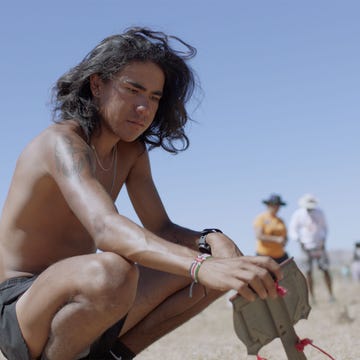The Farallon Islands are something of an ecological marvel. Rising out from the ocean 27 miles off the coast of San Francisco, their jagged peaks might not look particularly hospitable to life, but they’re home to a diverse host of marine animals, including seals, sea lions, salamanders, bugs, bats, and hundreds of species of year-round and migratory birds. Sometimes referred to as California’s Galapagos, the rocky archipelago serves as a welcome respite from the surrounding sea and a safe place to breed, nest, and have babies.
Two hundred years ago, the Farallons were frequented by another migratory animal: human beings. In the 1800s, Russian fur traders began harvesting seals and sea lions for their pelts, and later, amid a gold rush–induced shortage of chicken eggs, collectors scrambled along the shores coveting the speckled, red-yolked eggs of murre seabirds, inciting the vicious Egg Wars that decimated the murre population.
This essay was adapted from the Alta newsletter, delivered every Thursday.
SIGN UP
Eventually, egging was banned on the islands and, by 1969, so were most humans. Today, the territory is a national wildlife refuge, closed off to all but a select group of researchers and scientists.
However, another invasive species has thrown the local ecosystem out of balance. The tiny European house mouse hitched a ride with early human visitors and has become the center of a complex, decade-long debate among environmentalists.
During their peak season, these quick-breeding mice number in the tens of thousands on the islands, munching on critical native plant species and helping to spread the seeds of invasive plants. They also attract burrowing owls to the island, which wind up feeding on endemic species, such as rare ashy storm petrels, that evolved to live without predators.
Since the early 2000s, the U.S. Fish and Wildlife Service has been working on a strategy to eradicate what has been called a “plague-like infestation” of mice. Following a contentious seven-hour hearing in December 2021, the California Coastal Commission approved a plan to air-drop 2,880 pounds of the rodenticide brodifacoum onto the islands to completely eradicate the critters—a plan that some environmentalists are not too pleased with.
Banned in California except when being used for invasive species eradication on islands or for the occasional public health service, brodifacoum is a poisonous anticoagulant that causes internal bleeding in the animals that consume it. While most opponents of the eradication agree that the mice have got to go, they worry that the dropped pellets could be consumed by non-target species—or that poison in dead rodents could make its way up the food chain to the mice’s predators, including owls or migrating raptors.
It’s a complicated predicament with no clear “right” answer, and it raises a question that often comes up when trying to tackle complex environmental issues: Should humans take drastic measures to solve the problems we created, or will our meddling only make things worse?
Sara Wan, former California coastal commissioner and cofounder of Western Alliance for Nature, believes that the latter is true in this case. Wan fears the poison drop will expose both native birds and migrating visitors to face unnecessary risks. “They decided to do this bombing of the island in October or November, which is the peak of the raptor migration that goes along the flyaway, and the western flyway goes right over the islands,” says Wan.
Wan says officials should explore a safer, more multifaceted approach, including employing mousetraps and mouse contraceptives (a method that will likely remain in development for several more years). “There are alternatives, but it would require a combination of things, and it would take a little bit longer and be a little bit more difficult,” she says. “But it can be accomplished and it’s been done elsewhere.”
These problems are not unique to the Farallon Islands by any means. Humans have introduced non-native mammals to 90 percent of island archipelagoes worldwide through commerce and other travel, and in recent years, there has been a growing push to eliminate these creatures to preserve the planet’s biodiversity. Despite the fact that islands account for less than 6 percent of the world’s land mass, they are home to 15 percent of its species and represent 61 percent of recorded extinctions—a majority of which are caused by non-native species.
However, it’s difficult to completely eliminate the risk for native species that live on the island when rodenticides are used, and bird deaths have been an unfortunate byproduct of previous eradication efforts. In 2008, for instance, several hundred birds, including more than 40 bald eagles, died after a poisoning campaign on one of Alaska’s Aleutian Islands.
Scientists found, though, that many of the bird species were able to repopulate successfully, and the diversity of birds even increased in the years following. Proponents of the Farallon Islands poisoning plan say that while there’s no way to fully guarantee that native animals will not be harmed, preserving the long-term biodiversity of the island is worth the short-term sacrifice. They plan to mitigate the harm by using hazing techniques like “lasers, spotlights, pyrotechnics, biosonics, predator calls, air cannons, effigies, and kites” to scare away some birds while relocating others. Officials will also collect mouse carcasses following the poison dump, to remove temptation for raptors.
“Some nontarget animals will be lost, and we’re going to do everything we can to minimize that—we don’t take that lightly,” says Matt Brown, a project leader at the San Francisco Bay National Wildlife Rescue Complex. “But we also know that we’re losing animals because of the mice every day—it’s an impact that’s year-round, constant.”
As things stand, the Fish and Wildlife Service is set to finalize the plan in the coming months and drop the poison by the fall of 2023. While it remains uncertain what the long-term impacts might be, odds are this won’t be the last human-caused problem to affect the Farallon Islands, which also face a future filled with rising tides and warming waters. Let’s just hope it doesn’t take another decade of debate before humans start combatting that.•
Zoie Matthew is an L.A.-based journalist who covers the environment, housing, houselessness, and grassroots organizing. Her writing has appeared in LAist, Los Angeles magazine, Curbed, The Cut, and others. A graduate of the University of California, Irvine, her musings about Los Angeles, literature, baking, and birds can be found on her twitter.












